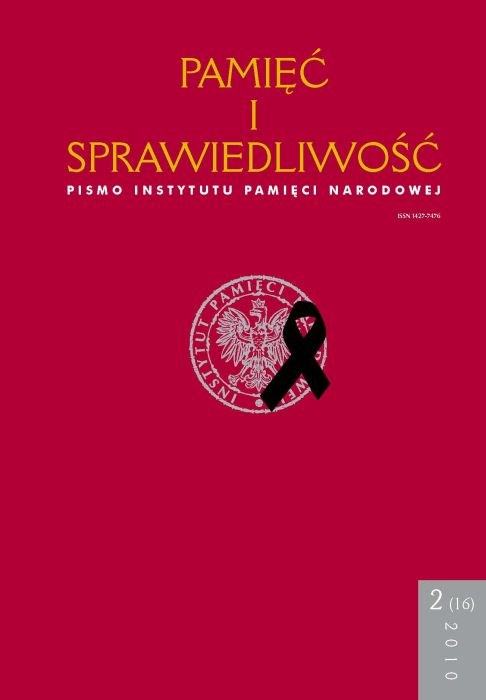„Ekstremiści, chuligani, politykierzy”. Obraz podziemnej „Solidarności” w propagandzie stanu wojennego
Pamięć i Sprawiedliwość, Tom 16 Nr 2 (2010), strony: 105-137
Data publikacji: 2010-12-30
Abstrakt
Polish authorities not only arrested hiding activists of the underground „Solidarity” („Solidarność”) movement but also made an effort to discredit them in society’s eyes. The official press emphasized the weakness of the opposition simultaneously exaggerating threats connected with its functioning. Besides, the „extremists” – as the underground’s leaders were called – were presented as those, who aimed for a confrontation with the authorities in order to take over the leadership of the country. What is more, the opposition was accused of betraying Poland and of going over to the PRL’s overseas enemies. An alleged “Solidarity’s” dependence on those countries was supposed to result from financial support for
its activity received from western governments and secret services. In addition to that, “Solidarity’s” members were reproached for popularizing terrorist methods of fighting with the authorities as well as for exploiting patriotic symbols.
Polish media were trying to prove that street demonstrations were principal methods of mounting active resistance to the communist government and its politics. Those events were presented in a way that only exposed a rowdy behaviour of the crowds, whereas aggressive actions taken by public law and order services were
well hidden. On the other hand, particular strikes organized by the underground were being, as far as possible, ignored, because their existence was in opposition to the image created by a socialist propaganda, according to which the “working class” did not support the opposition. Furthermore, the authorities sought to
marginalise a phenomenon of an underground literature by deriding its – alleged – poor essential content and low technical quality.
It is difficult to state how far Poles believed in the “enemy’s” image created by the media. Presumably, an “anti-Solidarity” propaganda yielded the best results in small towns and in the country. Simultaneously, there were some social groups such as young people of intelligentsia backgrounds and urbanized “working class” which might have been resistant to its influence. Common stereotypes about the “Solidarity’s” leaders were perpetuated among pro-communist communities and also among some representatives of ruling elites. It resulted in expressing their anxiety at participation of particular opposition’s members in the Polish Round Table Talks.
Inne teksty tego samego autora
- Jan Olaszek, Tomasz Kozłowski, Internowani w stanie wojennym. Dane statystyczne , Pamięć i Sprawiedliwość: Tom 16 Nr 2 (2010)
- Jan Olaszek, Konstanty Gebert – redaktor i publicysta prasy podziemnej , Pamięć i Sprawiedliwość: Tom 24 Nr 2 (2014)
- Shana Penn, Jan Olaszek, Wahadło przechylone w drugą stronę. Uwagi do książki Shany Penn, Sekret „Solidarności”. Kobiety, które pokonały komunizm w Polsce, Warszawa, WAB, 2014, ss. 448 , Pamięć i Sprawiedliwość: Tom 25 Nr 1 (2015)
- Jan Olaszek, Grzegorz Wołk, Drugi obieg wydawniczy w oczach Służby Bezpieczeństwa , Pamięć i Sprawiedliwość: Tom 21 Nr 1 (2013)
- Jan Olaszek, [Recenzje] Wokół pracy Pawła Sowińskiego Zakazana książka. Uczestnicy drugiego obiegu 1977–1989, Instytut Studiów Politycznych Polskiej Akademii Nauk, Warszawa 2011, 367 ss. , Pamięć i Sprawiedliwość: Tom 19 Nr 1 (2012)
 Język Polski
Język Polski
 English
English
 Deutsch
Deutsch
 Français (France)
Français (France)
 Italiano
Italiano
 Русский
Русский


 PDF
PDF
